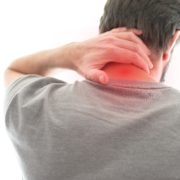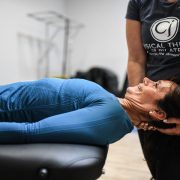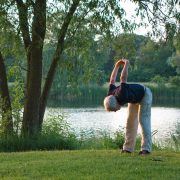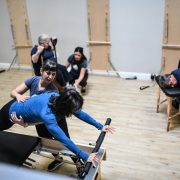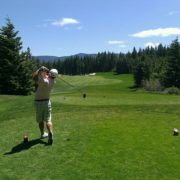Six Reasons to Try Pickleball this Father’s Day
If you’re looking for something fun and active to do this Father’s Day – why not try a game of Pickleball?
If you haven’t yet heard of pickleball – it’s quickly become one of the most popular racket sports in the country. It’s a paddle sport that combines elements of tennis, badminton, and ping-pong. Since the rules are fairly straightforward, it tends to attract people of all ages and skill levels – but it’s been a huge hit in the over-50 crowd. You can find both outdoor and indoor courts just about anywhere – and it provides a fantastic opportunity for the whole family to engage in a fun-filled day of friendly competition – while also honoring your favorite active dad.
Pickle ball also comes with a ton of health benefits.
Here are 6 of my favorite reasons why pickleball is good for your health – and why I think you should give it a try this Father’s Day:
1. Get’s the Heart Pumping:
Since Pickleball is a dynamic sport – it keeps you on the move – making it an excellent cardiovascular workout. When you play pickleball regularly – it can improve heart health, increase endurance, and strengthen your cardiovascular system. Pickleball consists of both aerobic exercises as well as bursts of anaerobic activity – such as quick sprints and lunging on the court. This helps to elevate your heart rate in a way that is great for promoting overall hearth health and cardiovascular fitness.
2. Weight Management:
Everyone knows you need both diet and exercise to effectively manage your weight. When it comes to exercise – why not pick something fun that you know you’re more likely to do because it’s enjoyable. The continuous movement involved in the sport of pickleball helps to burn calories and increase your metabolic rate. But it’s not just cardio that pickleball is known for – there is a strength component too. This combination of both strength and cardio only adds to your calorie-burning – making it not only fun – but an efficient way to manage your weight.
3. Improved Balance and Coordination:
Pickleball requires you to move quickly, change direction, and react to the ball’s trajectory. These dynamic movements help to improve balance and coordination because they force the engagement of multiple muscle groups at once. When you have to anticipate shots from any angle, pivot at a moment’s notice, and reach for the ball – this helps to enhance something called proprioception – your body’s ability to sense position in space. Since pickleball is super popular with the over 50 crowd, anything that works on balance and coordination is something I support – since these two areas only tend to decline as you age.
4. Increased Strength and Endurance:
When you play pickleball – you have to do everything from swing the paddle, lunge at the ball, and reach for shots. These varied physical movements help to engage just about all the muscles in your body – particularly your arms, shoulders, legs, and core. When you play pickleball regularly – it’s going to lead to improved muscular strength and endurance. Plus, pickleball is generally low-impact – so you get to improve your strength and endurance while not having a huge negative impact on your joints.
5. Cognitive and Mental Benefits:
The strategic aspects of pickleball – such as shot placement, anticipating your opponent’s moves, and the adaptation to different playing styles – challenges your brain and enhances mental agility in a fun and active way. For example, just the hand-eye coordination required to track the ball and make split-second decisions sharpens your cognitive skills and improves your reaction time to things. When you play pickleball regularly – you’ll find that your focus, concentration, and overall mental well-being will simply improve.
6. Social Interaction and Emotional Well-being:
This is probably my most favorite health benefit of pickleball. For the younger crowd (30’s and 40’s) – it’s quickly becoming one of the hottest business and networking events out there. And for everyone else, it’s a fabulous social sport that encourages interaction and camaraderie. Regardless of who you play with – whether it be friends, family, or in a community league – pickleball fosters a sense of belonging and enhances social connections. Plus, the positive connections you find on the court can easily extend off the court – so it becomes a fun and active way to quickly expand your social circles and overall well-being. Your new pickleball buddy could suddenly double as your gym and walking buddy too.
So there you have it – six healthy reasons to try Pickleball if haven’t already.
And why not use Father’s Day as the perfect excuse to to make it a family affair. With any new activity, there’s always a risk of injury, so make sure you warm-up properly and go into it with ease – especially if it’s your first time. And if you’re currently suffering from an injury that is keeping you from wanting to even try this super fun and accessible sport – consider talking to a movement or mechanical pain expert who can help you sort out what’s going on.
Are you local Portsmouth, NH?
Consider speaking to one of my specialists. Tell us everything that’s been going on with you, and determine for yourself if we’re the best people to help you. It’s a completely free, no-obligation appointment that will give you all the information you need to make the BEST decision for YOUR health – whether that’s working with us or not!
CLICK HERE to request a Free Discovery Session with one of my specialists.
Dr. Carrie Jose, Physical Therapist and Pilates expert, owns CJ Physical Therapy & Pilates in Portsmouth and writes for Seacoast Media group. To get in touch, or request a free copy of one of her guides to back, knee, neck or shoulder pain, visit her website www.cjphysicaltherapy.com or call 603-605-0402


